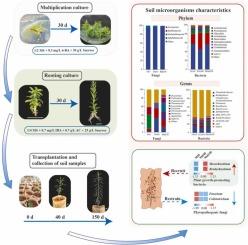Establishment of rapid propagation system of high-essential-oil Melaleuca alternifolia and characteristics of soil microorganisms during plantlet transitioning from aseptic to microorganism conditions
IF 6.2
1区 农林科学
Q1 AGRICULTURAL ENGINEERING
引用次数: 0
Abstract
Plant tissue culture is a valuable tool for the asexual propagation of valuable genotypes, enabling the conversion of tissue-cultured plantlets from a closed sterile environment to a natural environment, however, the influence of tissue-cultured plantlets on the characteristics of soil microbial communities during their gradual adaptation to the environment is still unknown. This study established a rapid propagation system for 4-terpineol type Melaleuca alternifolia and analyzed the changes in soil microbial community composition after transplanting tissue-cultured plantlets. The optimal formulation for proliferation was 1/2MS + 0.3 mg/L 6-BA + 30 g/L sucrose, and the average multiplicity was 4.04. The optimal rooting medium was 1/4MS + 0.7 mg/L IBA + 0.7 g/L AC + 25 g/L sucrose, and the rooting rate was 100 %. In the initial adaptation stage (40 d), the rhizosphere soil microorganisms of the tissue-cultured plantlets were characterized by drastic changes in the relative abundances of fungal genera greater than 10 % and a stable composition of bacterial genera, whereas in the complete adaptation stage (150 d), the number of dominant fungal genera with relative abundance of greater than 10 % increased, and the composition of the dominant bacterial genera remained stable. Throughout 4-terpineol type M. alternifolia domestication, the fungal genera with more than 10 % relative abundance changed, and the composition of the top 10 bacterial genera in terms of relative abundance was stable. The increase in the relative abundances of the beneficial bacterial genera Bradyrhizobium and Mesorhizobium, and the relative abundances of phytopathogenic fungi Fusarium and Colletotrichum decreased, may be related to the root exudates of 4-terpineol type M. alternifolia. The paper not only presents a rapid plant propagation system suitable for commercial use but also establishes a scientific foundation for the utilization of beneficial microorganisms to enhance the overall health of soil-plant systems.

高挥发油互花千层快速繁殖体系的建立及无菌化向微生物化过渡过程中土壤微生物特征
植物组织培养是有价值基因型无性繁殖的宝贵工具,可以使组织培养苗从封闭的无菌环境转化为自然环境,然而,组织培养苗在逐渐适应环境的过程中对土壤微生物群落特征的影响尚不清楚。本研究建立了4-松油醇型互花千层的快速繁殖体系,分析了组培苗移栽后土壤微生物群落组成的变化。最佳增殖配方为1/2MS + 0.3 mg/L 6-BA + 30 g/L蔗糖,平均增殖倍数为4.04。最佳生根培养基为1/4MS + 0.7 mg/L IBA + 0.7 g/L AC + 25 g/L蔗糖,生根率为100% %。在初始适应阶段(40 d),组织培养植株根际土壤微生物的特点是,相对丰度大于10 %的真菌属发生剧烈变化,菌属组成稳定;而在完全适应阶段(150 d),相对丰度大于10 %的优势真菌属数量增加,优势菌属组成保持稳定。在4-松油醇型互花蓟马驯化过程中,相对丰度大于10 %的真菌属发生了变化,相对丰度排名前10位的细菌属组成较为稳定。有益菌属慢生根瘤菌和中根瘤菌的相对丰度升高,而植物病原真菌镰刀菌和炭疽菌的相对丰度降低,可能与4-松油醇型互花松叶根分泌物有关。本文不仅提出了一种适合商业使用的植物快速繁殖系统,而且为利用有益微生物提高土壤-植物系统的整体健康奠定了科学基础。
本文章由计算机程序翻译,如有差异,请以英文原文为准。
求助全文
约1分钟内获得全文
求助全文
来源期刊

Industrial Crops and Products
农林科学-农业工程
CiteScore
9.50
自引率
8.50%
发文量
1518
审稿时长
43 days
期刊介绍:
Industrial Crops and Products is an International Journal publishing academic and industrial research on industrial (defined as non-food/non-feed) crops and products. Papers concern both crop-oriented and bio-based materials from crops-oriented research, and should be of interest to an international audience, hypothesis driven, and where comparisons are made statistics performed.
 求助内容:
求助内容: 应助结果提醒方式:
应助结果提醒方式:


